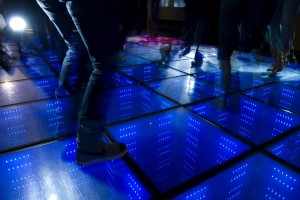By Anca Gagiuc on June 20, 2014 in News
Dutch artist Daan Roosegaarde has be en called “a hippie with a business plan” by the New York Times The Dutch are known for their love of nature – all those bicycles and parks are solid proof. Daan has taken this even further.
en called “a hippie with a business plan” by the New York Times The Dutch are known for their love of nature – all those bicycles and parks are solid proof. Daan has taken this even further.
“I made a decision not to stay in the white cube of the MoMa, with all due respect,” he says. “You need to make it public. You need to make it for everyone.” And that’s what he’s aiming for.
At SXSW this year, Daan took the audience on a “safari tour” of what our future world could look like. His expertise as dreamer reveals a future that has a natural glow, due to plants that produce their own light, smart highways that focus on road safety, smog rings that turn pollution into diamonds, and sustainable dance floors that capture the energy of dancers and use it to generate power for the surrounding building.
Luminous trees – the future public lighting turns into poetic landscapes
Swap streetlights with luminous trees – Daan Roosegaarde at SXSW from Dezeen on Vimeo.
Roosegaarde’s fondness for biomimicry (the imitation of the models, systems, and elements of nature for the purpose of solving complex human problems), combined with his attraction to marine life, especially the jelly fish, gave him the idea to try and use the same biological system to recreate trees into energy-neutral ones.
In collaboration with BioGlow founder Dr. Alexander Krichevsky and the State University of New York, the first plants of the kind were created and presented in Austin during the SXSW conference. This location was chosen because of the strict regulations within the EU regarding the use of genetically modified plants which forbid him to use them in his Netherlands studio. For Europe, the company currently employs a “biological paint” made of luciferin (the light-emitting compound found in organisms that generate luminescence, such as fireflies or jelly fish); both methods, he says, are harmless to the plant.
The Smart Highway
Futuristic highways glow in the dark by Daan Roosegaarde and Heijmans from Studio Roosegaarde on Vimeo.
The luminous trees idea led to an even brighter dream: the development of a smart highway that comes with some amazing features. It is covered with temperature-sensitive paints that change color as the temperature drops – when the road is icy, snowflakes would pop up as warning for the drivers, lined by the above-mentioned glowing trees, and marked with luminescent road lines that charge at daylight and give light at night to replace all these energy consuming street lights; they remain visible for 10 hours after nightfall. The first highway to test out the paint is in the Netherlands. Interactive lights help save energy by lighting up as a car approaches and turning off as it departs. An electric vehicle priority lane allows you to charge as you drive.
The Sustainable Dance Floor
Sustainable Dance Floor_ Daan Roosegaarde from Studio Roosegaarde on Vimeo.
It is known that movement produces energy. The simple action of walking can generate power, the only thing lacking being the ability to capture it and put it to good use. Roosegaarde designed an interactive dance floor which generates electricity through the simple act of dancing. Using the right materials that produce energy when mechanical stress is inflicted on them, known as the ‘piezoelectric effect’, can turn the dance floor into a big generator, transforming each movement into power. On a larger scale, this can be used throughout the cities, using every vibration to create clean energy.
The Smog Ring
Smog by Studio Roosegaarde from Dezeen on Vimeo.
Perhaps the most amazing project he’s designed, and which is tentatively scheduled to be implemented in the near future, is SMOG. It is the result of ion technology which cleans the air by creating a weak electromagnetic field that vacuums smog from the sky. Using the basic principles of physics – buried coils of copper wire, charged with relatively low voltage, they will magnetize and attract smog particles, making them fall down from the sky. And just one or two hours at night are sufficient.
Furthermore, in an attempt to create awareness and raise funds, a by-product is linked to the harsh reality of urban pollution – the smog ring – a piece of designer jewelry with a clear center stone with smog particles extracted from Beijing city air. The black dust, which in most part is soot from coal, will be shaped in a millimeter cube, symbolizing a cubic kilometer of smog the ring has cleared. It will come in two versions, available for purchase by the end of 2014: a less expensive version crafted using a hand-operated press, and a limited edition version with a diamond head. The diamond for the more expensive rings will be produced by mechanized presses capable of turning the particles of dirty urban air into the valuable stone.
Design is based on the Roosegaarde’s objective of pulling technology “out of the screen” and this has won him the Accenture Innovation Award, INDEX Award, World Technology Award, Charlotte Köhler Award, two Dutch Design Awards, and China’s Most Successful Design Award. He has been the focus of exhibitions at Tate Modern, National Museum in Tokyo, Victoria and Albert Museum, and more.


